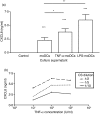Migration of polymorphonuclear leucocytes is influenced by dendritic cells
- PMID: 15720439
- PMCID: PMC1782099
- DOI: 10.1111/j.1365-2567.2005.02104.x
Migration of polymorphonuclear leucocytes is influenced by dendritic cells
Abstract
Dendritic cells (DCs) are the most potent antigen-presenting cells and populate many tissues where they may participate in inflammatory reactions. The infiltration of polymorphonuclear leucocytes (PMNLs) into tissues is a prominent feature of inflammation. The mechanisms of PMNL recruitment depend on chemotactic factors and adhesion molecules expressed on endothelial cells. The aim of the present study was to determine whether DCs participate in the early recruitment of PMNLs. Dendritic cells derived from peripheral blood monocytes were used for this study. PMNLs incubated with culture supernatant (CS) from untreated or from tumour necrosis factor-alpha (TNF-alpha)-treated (1 hr, 100 U/ml, 37 degrees ) monocyte-derived DCs (moDCs) had increased surface expression of both CD11b and CD18. Moreover, both untreated and TNF-alpha-treated moDCs induced PMNL chemotaxis. By blocking CXCL8, CXCL5, CXCL7 and Pan GRO (CXCL1, CXCL2, CXCL3), we observed that CXCL8/interleukin-8 might be the chemokine that induced the PMNL chemotactic activity in the CS of untreated and TNF-alpha-treated moDC. Furthermore, we investigated the regulation of CXCL8 production in moDCs by adhesion molecule engagement. Our data demonstrated that CD31, CD18, CD29 and CD49d participated in the adhesion of immature moDCs to endothelium. Moreover, engagement of domains 1-3 of CD31, but not of CD29 or CD18, decreased the production of CXCL8 by immature but not mature moDCs (which display lower CD31 levels than immature moDCs). Overall, these results suggest that DCs not only trigger a specific immune response, but also the innate immune response by recruiting PMNLs. Furthermore, our results also suggest that CXCL8 production by immature DCs might be regulated by signalling through CD31 during their migration through the vascular endothelium.
Figures









Similar articles
-
Dendritic cell adhesion to cerebral endothelium: role of endothelial cell adhesion molecules and their ligands.J Neuropathol Exp Neurol. 2009 Mar;68(3):300-13. doi: 10.1097/NEN.0b013e31819a8dd1. J Neuropathol Exp Neurol. 2009. PMID: 19225407
-
Adhesion of dendritic cells derived from CD34+ progenitors to resting human dermal microvascular endothelial cells is down-regulated upon maturation and partially depends on CD11a-CD18, CD11b-CD18 and CD36.Eur J Immunol. 2002 Dec;32(12):3638-50. doi: 10.1002/1521-4141(200212)32:12<3638::AID-IMMU3638>3.0.CO;2-C. Eur J Immunol. 2002. PMID: 12516552
-
Tumor necrosis factor-alpha (TNF-alpha) induces integrin CD11b/CD18 (Mac-1) up-regulation and migration to the CC chemokine CCL3 (MIP-1alpha) on human neutrophils through defined signalling pathways.Cell Signal. 2008 Mar;20(3):557-68. doi: 10.1016/j.cellsig.2007.11.008. Epub 2007 Nov 26. Cell Signal. 2008. PMID: 18164590
-
Differentiation and function of mouse monocyte-derived dendritic cells in steady state and inflammation.Immunol Rev. 2010 Mar;234(1):90-104. doi: 10.1111/j.0105-2896.2009.00876.x. Immunol Rev. 2010. PMID: 20193014 Review.
-
Modulation of atherogenesis by chemokines.Trends Cardiovasc Med. 2004 May;14(4):161-5. doi: 10.1016/j.tcm.2004.02.006. Trends Cardiovasc Med. 2004. PMID: 15177267 Review.
Cited by
-
Upon viral exposure, myeloid and plasmacytoid dendritic cells produce 3 waves of distinct chemokines to recruit immune effectors.Blood. 2006 Apr 1;107(7):2613-8. doi: 10.1182/blood-2005-07-2965. Epub 2005 Nov 29. Blood. 2006. PMID: 16317096 Free PMC article.
-
15 kDa Granulysin versus GM-CSF for monocytes differentiation: analogies and differences at the transcriptome level.J Transl Med. 2011 Apr 18;9:41. doi: 10.1186/1479-5876-9-41. J Transl Med. 2011. PMID: 21501511 Free PMC article.
-
The CSF Levels of Neutrophil-Related Chemokines in Patients with Neuromyelitis Optica.Ann Clin Transl Neurol. 2020 Jul;7(7):1245-1251. doi: 10.1002/acn3.51094. Epub 2020 Jun 9. Ann Clin Transl Neurol. 2020. PMID: 32515897 Free PMC article.
-
Oral mucosal dendritic cells and periodontitis: many sides of the same coin with new twists.Periodontol 2000. 2007;45:35-50. doi: 10.1111/j.1600-0757.2007.00222.x. Periodontol 2000. 2007. PMID: 17850447 Free PMC article. Review. No abstract available.
-
Stimulatory interactions between human coronary smooth muscle cells and dendritic cells.PLoS One. 2014 Jun 16;9(6):e99652. doi: 10.1371/journal.pone.0099652. eCollection 2014. PLoS One. 2014. PMID: 24932497 Free PMC article.
References
-
- Pober JS, Cotran RS. Cytokines and endothelial cell biology. Physiol Rev. 1990;70:427–51. - PubMed
-
- Springer TA. Traffic signals for lymphocyte recirculation and leukocyte emigration: the multistep paradigm. Cell. 1994;76:301–14. - PubMed
-
- Mollinedo F, Borregaard N, Boxer LA. Novel trends in neutrophil structure, function and development. Immunol Today. 1999;20:535–7. - PubMed
-
- Banchereau J, Steinman RM. Dendritic cells and the control of immunity. Nature. 1998;392:245–52. - PubMed
Publication types
MeSH terms
Substances
LinkOut - more resources
Full Text Sources
Research Materials

